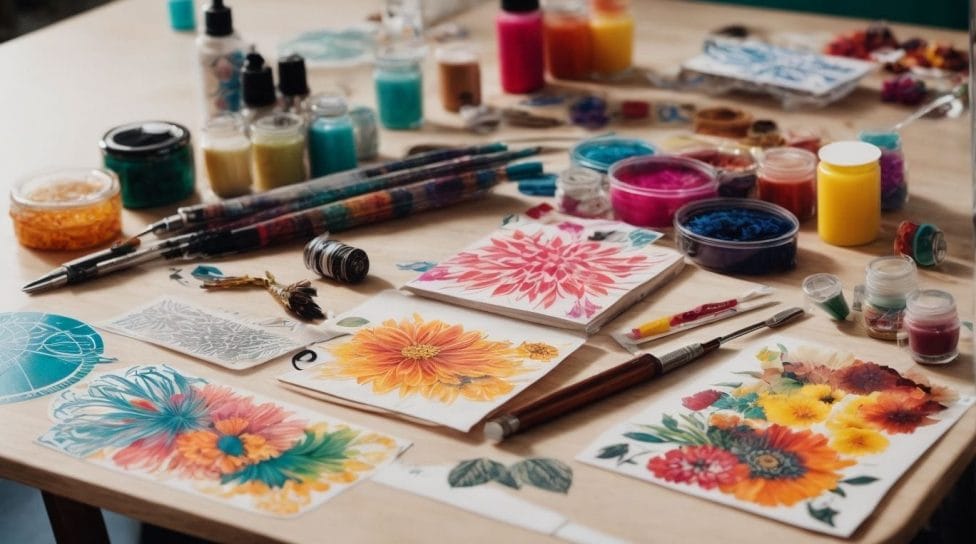Temporary tattoos are a popular and creative way to express oneself without the commitment of permanent ink. Whether you want to try out a design before getting a permanent tattoo or enjoy the temporary aesthetic, there are various methods for making temporary tattoos. In this article, we will explore the different methods and materials required and provide a step-by-step guide to creating your temporary tattoos.
Methods of Making Temporary Tattoos:
- Using Homemade Tattoo Stencils
- Creating Freehand Temporary Tattoos
- Using Temporary Tattoo Kits
Materials Required for Making Temporary Tattoos:
- Tattoo Stencils or Design Templates
- Transfer Paper
- Tattoo Ink or Pen
- Alcohol Pads or Baby Oil
- Sealant or Setting Spray
Step-by-Step Guide to Making Temporary Tattoos:
- – Step 1: Choose a Design
- – Step 2: Clean and Prepare the Skin
- – Step 3: Transfer the Design onto Transfer Paper
- – Step 4: Apply the Tattoo onto the Skin
- – Step 5: Set and Seal the Tattoo
Tips and Precautions for Making Temporary Tattoos:
- Test the Ink or Pen on a Small Area of Skin
- Avoid Applying Tattoos on Damaged or Sensitive Skin
- Follow Proper Hygiene Practices
- Avoid Rubbing or Scrubbing the Tattoo
- Be Mindful of Allergies or Skin Sensitivities
By following these methods, using the right materials, and taking the necessary precautions, you can create your temporary tattoos at home. So, let’s dive into the details and enjoy the fun and creativity of temporary tattoo art!
Key takeaways:
- Creating temporary tattoos at home: Temporary tattoos can be made using homemade stencils, freehand techniques, or temporary tattoo kits.
- Materials needed for temporary tattoos: Tattoo stencils, transfer paper, tattoo ink or pen, alcohol pads or baby oil, and a sealant or setting spray are essential materials for making temporary tattoos.
- Step-by-step guide: Choose a design, prepare the skin, transfer the design onto transfer paper, apply the tattoo onto the skin, and finally, set and seal the tattoo to make temporary tattoos.
Methods of Making Temporary Tattoos

Photo Credits: Tattooineplanet.Com by Christopher Nelson
If you want to up your temporary tattoo game, we’ve got you covered! In this section, we’re diving into the exciting world of making temporary tattoos. From using homemade tattoo stencils to creating freehand designs and even exploring the convenience of temporary tattoo kits, we’ve got all the methods covered. Get ready to unleash your creativity and learn how to rock those awesome temporary tattoos like a pro!
Using Homemade Tattoo Stencils
Using homemade tattoo stencils can be a fun and creative way to make temporary tattoos. Here is a step-by-step guide to using homemade tattoo stencils:
1. Design your stencil: Draw or print out your desired design on a firm piece of paper or cardboard.
2. Cut out the stencil: Use a sharp craft knife to ut out the design carefully, creating a stencil carefully.
3. Clean the skin: Prepare the area where you want to apply the tattoo by cleaning it with soap and water.
4. Secure the stencil: Place the homemade tattoo stencils on the cleaned skin and use adhesive or tape to secure it in place.
5. Apply ink or pen: Using a safe and non-toxic ink or pen, carefully fill in the cutout areas of the stencil with your chosen colors.
6. Remove the stencil: Gently peel off the stencil from the skin to reveal your homemade tattoo design.
7. Let it dry: Allow the tattoo to dry completely before touching or moving the area.
8. Seal the tattoo (optional): If desired, apply a thin layer of setting spray or clear sealant to help the tattoo last longer.
Remember always to practice proper hygiene when making and applying homemade tattoos.
Creating Freehand Temporary Tattoos
- Create unique temporary tattoos: Enjoy the freedom of creating freehand temporary tattoos that allow for artistic freedom and customization.
- Prep and clean your skin: Before applying the tattoo, make sure to thoroughly wash and dry the area where you want to place it.
- Draw directly on your skin: Utilize a skin-safe pen or tattoo ink to draw your desired design directly onto your skin.
- Perfect your design: Take your time refining and finalizing your artwork, making any necessary adjustments along the way.
- Ensure longevity and adherence: Enhance the staying power of your temporary tattoo by applying a sealant or setting spray.
True story: Sarah craved a distinctive symbol for her upcoming journey, so she leveraged her artistic skills to fashion a freehand temporary tattoo resembling a compass on her forearm. Its lifelike appearance fooled many into thinking it was a permanent fixture! Sarah relished the freedom to design her tattoo and had the opportunity to exhibit her boundless creativity.
Using Temporary Tattoo Kits
- Using temporary tattoo kits is a popular and convenient way to create temporary tattoos at home. Here is a step-by-step guide to using temporary tattoo kits:
- Choose a design: Select a design from the temporary tattoo kit that you like.
- Clean and prepare the skin: Clean the area where you want to apply the tattoo and make sure it is dry.
- Transfer the design onto the transfer paper: Follow the instructions in the temporary tattoo kit to transfer the design onto the transfer paper.
- Apply the tattoo onto the skin: Carefully place the transfer paper with the design on the desired area of the skin.
- Set and seal the tattoo: Use the setting spray or sealant provided in the temporary tattoo kit to secure the tattoo and make it last longer.
Using temporary tattoo kits allows for easy and temporary body art, making it a fun and creative activity for individuals of all ages.
Materials Required for Making Temporary Tattoos

Photo Credits: Tattooineplanet.Com by Austin Flores
Are you looking to DIY temporary tattoos? Let’s dive into the essential materials you’ll need to get started. From tattoo stencils or design templates to transfer paper, tattoo ink or pen, alcohol pads or baby oil, and a sealant or setting spray, we’ll explore everything you need to bring your temporary tattoo creations to life. So, grab your artistic spirit, and let’s uncover the key materials required for making your very own temporary tattoos.
Tattoo Stencils or Design Templates
Using tattoo stencils or design templates is a crucial step in the creation of temporary tattoos. These stencils assist in achieving precise and intricate designs, eliminating the need for artistic skills. Here is a comprehensive list of key aspects to keep in mind while utilizing tattoo stencils or design templates:
- Quality: It is essential to select high-quality stencils or templates to ensure clear and well-defined outlines in the tattoos.
- Size: Choose the appropriate size that perfectly fits the desired placement on the skin for optimal results.
- Versatility: Opt for stencils or templates that offer a wide range of designs to cater to varied preferences and themes.
- Adhesion: It is crucial to ensure that the stencil or template adheres securely to the skin surface to avoid any smudging or distortion during the tattooing process.
- Ease of use: Look for stencils or templates that are easy to apply and remove, facilitating a seamless tattoo creation experience.
By considering these factors, you can effectively utilize tattoo stencils or design templates for the creation of professional-looking temporary tattoos.
Transfer Paper
Transfer paper is an essential material used in the creation of temporary tattoos. It serves as a medium to transfer the desired design onto the skin. The provided table offers a comprehensive overview of important details regarding the transfer paper:
| Importance | Transfer paper allows for the accurate and precise transfer of designs onto the skin. |
| Function | Transfer paper acts as an intermediary, transferring the ink or design from the tattoo stencil or template onto the skin. |
| Type | There are various types of transfer paper available, including carbon-based transfer paper and thermal transfer paper. |
| Usage | To use transfer paper, place it on top of the tattoo stencil or design template, ensuring the ink side is facing down. Apply pressure to transfer the design onto the skin. |
| Availability | Transfer papers can be obtained from arts and crafts stores or online retailers that specialize in temporary tattoo supplies. |
Tattoo Ink or Pen
When it comes to temporary tattoos, the choice of tattoo ink or pen is crucial in achieving the desired design and longevity of the tattoo. Consider the following options:
- When it comes to tattoo ink or pen, Henna is a natural and plant-based ink that creates intricate and reddish-brown designs.
- Tattoo ink or pen is also available in the form of Temporary Tattoo Pens, which offer a variety of colors and precise application for detailed designs.
- Another option for tattoo ink or pen is Airbrush Ink, which is best for larger, vibrant, and durable temporary tattoos, making it ideal for events or performances.
- If you prefer tattoo ink or a pen that is safe for all skin types, Water-based Ink is the way to go. It allows for easy application and removal with soap and water.
- Gel Pens are another choice for tattoo ink or pen as they provide a smooth application and are suitable for creating colorful temporary tattoos on the skin.
Choose the tattoo ink or pen based on your preferences, the design complexity, desired longevity, and ease of application and removal.
Alcohol Pads or Baby Oil
Using alcohol pads or baby oil is crucial when creating temporary tattoos. These materials play specific roles in the process, ensuring a secure and successful application.
- Alcohol Pads: Prior to applying the tattoo, it is necessary to cleanse the skin using alcohol pads. This step removes any oil or dirt that might hinder the tattoo from adhering properly, and it helps establish a clean canvas for the design.
- Baby Oil: Once you have enjoyed your temporary tattoo, it can be effortlessly eliminated by using baby oil. Apply the oil onto a cotton ball and gently rub it over the tattoo until it gradually fades away. Baby oil is a gentle and effective method for removing temporary tattoos without causing any skin irritation or damage.
Sealant or Setting Spray
A sealant or setting spray is an essential product when making temporary tattoos. It helps to protect the design and make it last longer. After applying the tattoo onto the skin, carefully spray the sealant or setting spray over the tattoo. This will create a barrier that prevents the tattoo from smudging or fading. It also aids in enhancing the vibrancy of the colors. Look for a sealant or setting spray specifically designed for temporary tattoos, as it will be non-toxic and safe for use on the skin. Applying a sealant or setting spray is the final step in creating a professional-looking temporary tattoo.
Step-by-Step Guide to Making Temporary Tattoos

Photo Credits: Tattooineplanet.Com by Gary Nguyen
Creating temporary tattoos can be a fun and expressive way to adorn your skin without the permanence of permanent ink. In this step-by-step guide, we’ll take you through the process of making your temporary tattoos. From choosing a design that suits your style to applying and sealing the tattoo, each sub-section will provide clear instructions to help you achieve stunning temporary body art. So, let’s dive in and learn how to create your temporary tattoos in no time!
Step 1: Choose a Design
When creating temporary tattoos, the initial step is selecting a design that you desire to replicate on your skin. This is a crucial step as it determines the overall appearance of your temporary tattoo. Here is a step-by-step tutorial on how to pick a design for your temporary tattoo:
Consider your preferences: Take into account your interests, hobbies, or any symbols that bear special significance to you. This will assist you in narrowing down the design options.
Seek inspiration: Explore tattoo magazines, websites, or social media platforms for ideas. You can also create your design by combining different elements.
Size and Placement: Determine the size and placement of your temporary tattoo. Consider aspects like visibility and whether you want it to be a focal point or more discreet.
Sketch or print the design: Once you have selected a design, sketch it on paper or print it out. This will provide you with a visual reference when transferring the design onto the transfer paper.
Fact: Throughout history, temporary tattoos have been utilized in diverse cultures for celebrations, religious rituals, and self-expression.
Step 2: Clean and Prepare the Skin
Step 2: Cleaning and preparing the skin is an essential part of making temporary tattoos. Follow these steps to ensure a clean and safe application:
- Wash the skin: Use mild soap and water to cleanse the area where the tattoo will be applied. Gently scrub to remove any dirt, oils, or lotions.
- Dry the skin: Pat the area dry with a clean towel. Make sure the skin is completely dry before applying the tattoo.
- Disinfect the skin: Use an alcohol pad to wipe the area. This helps remove any bacteria or germs that could cause infection.
- Avoid lotions or oils: Do not apply any moisturizers, lotions, or oils to the skin before applying the tattoo. These can create a barrier and affect the tattoo’s adherence.
- Shave the area (if needed): If there is hair on the skin where the tattoo will be applied, shave it carefully to ensure a smooth surface.
Step 3: Transfer the Design onto Transfer Paper
- Choose a design: Select the design you want to transfer onto your skin.
- Clean and prepare the skin: Ensure the skin is clean and dry before applying the transfer.
- Step 3: Transfer the Design onto Transfer Paper: Place the transfer paper over the design and trace it with a pen or pencil. Make sure the design is facing the correct way.
- Apply the tattoo onto the skin: Carefully place the transfer paper, design down, onto the desired area of skin.
- Set and seal the tattoo: Gently press a damp cloth or sponge onto the back of the transfer paper to moisten it. Hold the paper firmly in place for about 30 seconds, then peel off the paper to reveal your temporary tattoo.
Step 4: Apply the Tattoo onto the Skin
To successfully apply a temporary tattoo onto the skin, carefully follow these steps:
- Step 1: Clean the skin – Make sure that the area where you will apply the tattoo is clean and free from any oils or lotions.
- Step 2: Peel off the backing – Remove the protective backing from the temporary tattoo.
- Step 3: Place the tattoo – Gently press the tattoo onto the desired area of the skin with the design facing down.
- Step 4: Apply the Tattoo onto the Skin – Using a damp cloth or sponge, thoroughly wet the back of the tattoo.
- Step 5: Hold and wait – Keep the wet cloth on the tattoo for approximately 30 seconds to allow the design to adhere to the skin.
- Step 6: Peel off the paper – Carefully remove the paper backing, leaving the tattoo on the skin.
- Step 7: Let it dry – Allow the tattoo to air dry for a few minutes to ensure it sets completely.
By following these steps, you can effectively apply a temporary tattoo to your skin.
Step 5: Set and Seal the Tattoo
- Once the tattoo is applied to the skin, gently pat it down to ensure it adheres properly.
- Allow the tattoo to dry completely before applying any sealant or setting spray.
- Choose a suitable sealant or setting spray, such as a clear hairspray or a specialized tattoo sealant.
- Hold the sealant or setting spray about 6 inches away from the tattoo and spray a light, even coat over the entire design.
- Step 5: Set and Seal the Tattoo. Avoid touching or rubbing the tattoo until the sealant is completely dry.
By following these steps, you can ensure that your temporary tattoo stays in place and lasts longer.
Tips and Precautions for Making Temporary Tattoos

Photo Credits: Tattooineplanet.Com by Jeffrey White
Are you looking to create some temporary tattoos? Before you dive in, let’s talk about the essential tips and precautions you need to keep in mind. We’ll cover important aspects such as testing the ink or pen on a small area of skin, avoiding application on damaged or sensitive skin, following proper hygiene practices, and why it’s crucial to resist the temptation of rubbing or scrubbing the tattoo. Get ready to ink responsibly and rock those temporary tattoos with confidence!
Test the Ink or Pen on a Small Area of Skin
Before applying a temporary tattoo to your skin, it’s crucial to test the ink or pen on a small area of skin to ensure that you won’t have any adverse reactions. Here is a step-by-step guide on how to test the ink or pen:
- Clean the area: Start by cleaning a small area of your skin where you plan to apply the tattoo.
- Apply the ink or pen: Use a cotton swab or brush to apply a small amount of the ink, or draw a small line with the pen on the cleaned area.
- Wait and observe: Allow the ink or pen to dry and leave it undisturbed for at least 24 hours.
- Check for any reactions: After 24 hours, test the area for any signs of irritation, redness, or discomfort.
- If there are no adverse reactions: If you don’t experience any negative reactions, it should be safe to proceed with applying the temporary tattoo.
Keep in mind that everyone’s skin is different, so it’s essential to test the ink or pen on your skin before applying it to a larger area. If you do experience any adverse reactions, it’s best to avoid using that particular ink or pen.
Avoid Applying Tattoos on Damaged or Sensitive Skin
When making temporary tattoos, it is vital to avoid applying them on skin that is damaged or sensitive. It is important to acknowledge that putting tattoos on such skin can cause irritation, infection, or other adverse reactions. Prior to applying the tattoo, it is crucial to ensure that the skin is clean and devoid of any open wounds, cuts, rashes, or allergies. To check for any allergic reactions, it is advisable to test the ink or pen on a small area of the skin. Following proper hygiene practices, like thoroughly washing your hands and using clean materials, is essential. By taking these precautions, you can guarantee a safe and pleasurable temporary tattoo experience.
Follow Proper Hygiene Practices
- It is essential to follow proper hygiene practices to ensure safe and hygienic temporary tattoo application.
- Before applying the tattoo, make sure to clean the skin thoroughly.
- To avoid introducing bacteria or dirt, wash your hands with soap and water.
- Minimize the risk of contamination by using disposable gloves.
- Sanitize all tools, including tattoo stencils and ink pens, before using them.
- Prevent cross-contamination by avoiding the sharing of tattoo equipment.
- Make sure to apply the tattoo using a clean and sterile applicator.
- After application, protect the tattoo from bacteria and friction by covering it with a clean bandage or film.
- To ensure proper aftercare, gently clean the tattoo with mild soap and water.
- Prevent infection by keeping the tattooed area clean and dry.
- Follow any additional instructions provided by the tattoo kit or professional artist.
Avoid Rubbing or Scrubbing the Tattoo
When you have a temporary tattoo, it’s important to avoid certain actions that could damage or remove it prematurely. Here are some tips to prevent rubbing or scrubbing the tattoo:
Be gentle: Avoid rubbing or scrubbing the tattooed area, as this can cause the design to fade or come off.
Avoid scratching: If you experience itching, refrain from scratching the tattoo. Instead, lightly pat the area to alleviate any discomfort.
Don’t use harsh soaps: When cleaning the tattooed skin, opt for mild, fragrance-free soap and pat the area dry with a soft towel.
Avoid exfoliation: Stay away from exfoliating products or scrubbing brushes that could remove the temporary tattoo.
By following these precautions, you can ensure that your temporary tattoo lasts longer and maintains its vibrant appearance.
Be Mindful of Allergies or Skin Sensitivities

Photo Credits: Tattooineplanet.Com by Douglas Harris
“`
When creating temporary tattoos, it’s important to be mindful of allergies or skin sensitivities to ensure a safe and enjoyable experience.
- Research ingredients: Check the ingredients of the temporary tattoo products to avoid any known allergens or irritants.
- Test a small area: Before applying the temporary tattoo, test a small area of your skin to check for any allergic reactions or sensitivity.
- Avoid sensitive areas: Be cautious when applying temporary tattoos to sensitive areas like the face or near the eyes.
- Follow instructions: Follow the instructions provided with the temporary tattoo product to ensure proper application and removal.
Fact: Did you know that temporary tattoos are a fun and safe way to express yourself without the commitment of permanent ink?
Some Facts About How to Make Temporary Tattoos:
- ✅ Temporary tattoos are a great option for those who are hesitant to get permanent tattoos. (Source: Our Team)
- ✅ To make temporary tattoos, start by printing the designs on printable tattoo paper. (Source: Our Team)
- ✅ The Canon PIXMA iP8720 printer is recommended for its high-quality prints when making temporary tattoos. (Source: Our Team)
- ✅ After printing, follow the instructions on the tattoo paper, including adding a plastic film to the paper. (Source: Our Team)
- ✅ To apply the temporary tattoo, use a wet cloth on the back of the paper and then peel it off. (Source: Our Team)


